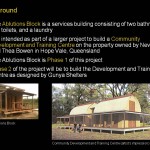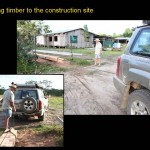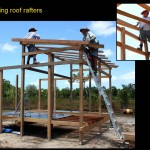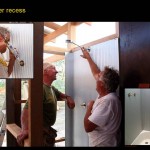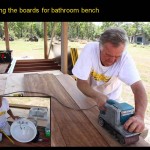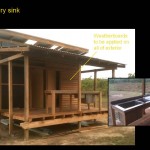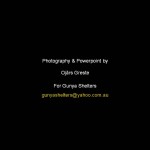our projects
Sep 14th, 2009 by Ross Woodcock
A slide presentation on our Hope Vale project in Northern Queensland is presented below:
Click here to read all about the project on the Hope Vale page.
Click here to view or download a PDF version of this presentation.
Background to our Projects – by Ross Woodcock
Through close contact with the Bowens in the course of several visits to Hope Vale over the years, I developed an understanding of how aboriginal people see living space. I perceive that Aboriginal people have a different conception of space to the way we white westerners see space. The Aboriginal preference is for open space. Their concept of space is to do with family and relationships with people, and not to do with organizational space (living room, kitchen etc).
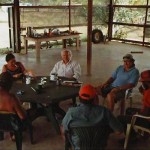 The Bowens live in a conventional Aussie suburban style house built of concrete blocks. However, adjacent to their house is a huge shed, and it is in the shed that they really live. They use the house only for sleeping in. Though the house has a kitchen, they more often cook on an open fire that’s lit in a 44 gallon drum split in half. It’s in the shed where they have cups of tea, eat their meals and spend time with members of their extended families and friends, play guitars and sing.
The Bowens live in a conventional Aussie suburban style house built of concrete blocks. However, adjacent to their house is a huge shed, and it is in the shed that they really live. They use the house only for sleeping in. Though the house has a kitchen, they more often cook on an open fire that’s lit in a 44 gallon drum split in half. It’s in the shed where they have cups of tea, eat their meals and spend time with members of their extended families and friends, play guitars and sing.
 Out of these observations grew the eco house Australia Gunya Shelters design that recognized Aboriginal sensibilities about space, and the climatic factors of far north Queensland. In addition to the physical design aspects, I also recognize that indigenous people need to gain more ownership of building their own homes – having a greater stake in both the supply of materials and labour. Up till now, they have been consumers of products produced by construction companies, with their only possible input being to supply labour for these companies. The Gunya Shelters design is simple and can be built by suitably trained labour. My vision is that the community in Hope Vale could form their own construction company, building “Gunyas”, providing continuity of work, and thus break the cycle of dependency on welfare.
Out of these observations grew the eco house Australia Gunya Shelters design that recognized Aboriginal sensibilities about space, and the climatic factors of far north Queensland. In addition to the physical design aspects, I also recognize that indigenous people need to gain more ownership of building their own homes – having a greater stake in both the supply of materials and labour. Up till now, they have been consumers of products produced by construction companies, with their only possible input being to supply labour for these companies. The Gunya Shelters design is simple and can be built by suitably trained labour. My vision is that the community in Hope Vale could form their own construction company, building “Gunyas”, providing continuity of work, and thus break the cycle of dependency on welfare.
For years I promoted this concept through conventional government channels that deal with Aboriginal housing. I had many high ranking decision makers come to look at the prototype that I had built on my property in Exeter NSW. Even the Minister for Aboriginal affairs in the previous coalition government, Mal Brough, sent a representative to look. All expressed great interest. The Gunya concept received favourable comment in a Government report on low cost Aboriginal housing. But when it came to awarding contracts, the government gave contracts to the major construction companies. I finally gave up on working through Government and started approaching private sponsors instead.


